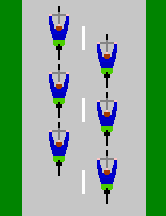Belgian spinning top
Belgian roundabout (also Belgian series) describes a formation in cycling that enables a group of cyclists to drive in an energy-saving manner by effectively exploiting the slipstream and relieving them of leadership work.
procedure
The Belgian roundabout consists of two individual rows that move against each other, that is, one row drives faster, the other (replaced driver) about 2 km / h slower. At the beginning of the formation, the leader of the faster row changes to the side into the slower one as soon as his rear wheel has completely passed the front wheel of the leader of this row. At the end of the formation, the last rider in the row of relieved riders changes over to the rear wheel of the last rider in the faster row. As a result, the formation as a whole “spins”.
A group of experienced drivers also take the angle of the wind into account at the Belgian gyro. When the wind comes in from the side, the riders drive laterally offset, with the front wheel being located roughly between the gearshift and the bottom bracket of the person in front. They spin so that the row moving forward drives on the leeward side. This avoids that the driver who goes out of the lead still has to “drive around” the front wheel of his successor. To do this, he would have to accelerate briefly and switch sides at the right moment - a technique that requires a well-rehearsed team (so-called "overhead detachment"). If the side from which the wind is falling changes in the course of the route, the direction of rotation of the gyro may have to be changed.
By this procedure, the guide and the work are Slipstreaming evenly distributed between the drivers of the gyro. The air resistance caused by high speeds and strong headwinds only affect two drivers at a time. The process should ideally be fluid and the same position should only be occupied for two to five seconds at the most. Often those who “fall” do not reduce their speed sufficiently, so that the fast row is forced to drive too long in the wind or to become permanently faster.
This form of formation riding was developed in Belgium , where cyclists constantly have to deal with strong and changing winds. These formations can often be seen in groups of outliers.
literature
- Ralf Schröder: Lexicon cycling . Göttingen 2005, ISBN 3-89533-473-1 , p. 46.
